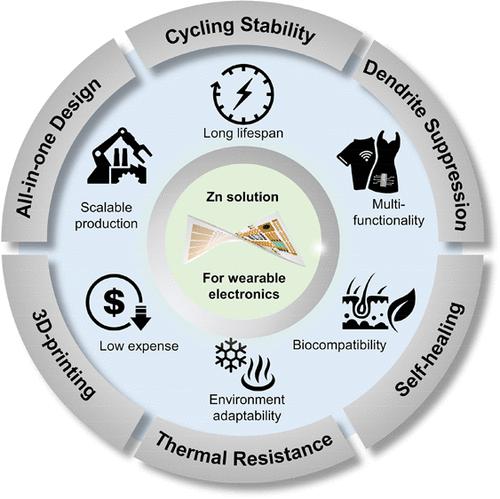Our official English website, www.x-mol.net, welcomes your
feedback! (Note: you will need to create a separate account there.)
Rational Design of Flexible Zn-Based Batteries for Wearable Electronic Devices
ACS Nano ( IF 15.8 ) Pub Date : 2023-01-30 , DOI: 10.1021/acsnano.2c09509 Xiao Xiao 1 , Zhiyang Zheng 1 , Xiongwei Zhong 1 , Runhua Gao 1 , Zhihong Piao 1 , Miaolun Jiao 1 , Guangmin Zhou 1
ACS Nano ( IF 15.8 ) Pub Date : 2023-01-30 , DOI: 10.1021/acsnano.2c09509 Xiao Xiao 1 , Zhiyang Zheng 1 , Xiongwei Zhong 1 , Runhua Gao 1 , Zhihong Piao 1 , Miaolun Jiao 1 , Guangmin Zhou 1
Affiliation

|
The advent of 5G and the Internet of Things has spawned a demand for wearable electronic devices. However, the lack of a suitable flexible energy storage system has become the “Achilles’ Heel” of wearable electronic devices. Additional problems during the transformation of the battery structure from conventional to flexible also present a severe challenge to the battery design. Flexible Zn-based batteries, including Zn-ion batteries and Zn–air batteries, have long been considered promising candidates due to their high safety, eco-efficiency, substantial reserve, and low cost. In the past decade, researchers have come up with elaborate designs for each portion of flexible Zn-based batteries to improve the ionic conductivities, mechanical properties, environment adaptabilities, and scalable productions. It would be helpful to summarize the reported strategies and compare their pros and cons to facilitate further research toward the commercialization of flexible Zn-based batteries. In this review, the current progress in developing flexible Zn-based batteries is comprehensively reviewed, including their electrolytes, cathodes, and anodes, and discussed in terms of their synthesis, characterization, and performance validation. By clarifying the challenges in flexible Zn-based battery design, we summarize the methodology from previous investigations and propose challenges for future development. In the end, a research paradigm of Zn-based batteries is summarized to fit the burgeoning requirement of wearable electronic devices in an iterative process, which will benefit the future development of Zn-based batteries.
中文翻译:

可穿戴电子设备柔性锌基电池的合理设计
5G和物联网的到来催生了对可穿戴电子设备的需求。然而,缺乏合适的柔性储能系统已成为可穿戴电子设备的“阿喀琉斯之踵”。电池结构从传统结构向柔性结构转变过程中的其他问题也对电池设计提出了严峻挑战。柔性锌基电池,包括锌离子电池和锌空气电池,由于其安全性高、生态效率高、储量大和成本低,长期以来一直被认为是有前途的候选者。在过去十年中,研究人员对柔性锌基电池的每个部分进行了精心设计,以提高离子电导率、机械性能、环境适应性和可扩展生产。总结报告的策略并比较它们的优缺点将有助于进一步研究柔性锌基电池的商业化。在这篇综述中,全面回顾了当前开发柔性锌基电池的进展,包括它们的电解质、正极和负极,并讨论了它们的合成、表征和性能验证。通过阐明柔性锌基电池设计中的挑战,我们总结了以往研究的方法,并提出了未来发展的挑战。最后,总结了锌基电池的研究范式,以适应可穿戴电子设备在迭代过程中不断增长的需求,这将有利于锌基电池的未来发展。
更新日期:2023-01-30
中文翻译:

可穿戴电子设备柔性锌基电池的合理设计
5G和物联网的到来催生了对可穿戴电子设备的需求。然而,缺乏合适的柔性储能系统已成为可穿戴电子设备的“阿喀琉斯之踵”。电池结构从传统结构向柔性结构转变过程中的其他问题也对电池设计提出了严峻挑战。柔性锌基电池,包括锌离子电池和锌空气电池,由于其安全性高、生态效率高、储量大和成本低,长期以来一直被认为是有前途的候选者。在过去十年中,研究人员对柔性锌基电池的每个部分进行了精心设计,以提高离子电导率、机械性能、环境适应性和可扩展生产。总结报告的策略并比较它们的优缺点将有助于进一步研究柔性锌基电池的商业化。在这篇综述中,全面回顾了当前开发柔性锌基电池的进展,包括它们的电解质、正极和负极,并讨论了它们的合成、表征和性能验证。通过阐明柔性锌基电池设计中的挑战,我们总结了以往研究的方法,并提出了未来发展的挑战。最后,总结了锌基电池的研究范式,以适应可穿戴电子设备在迭代过程中不断增长的需求,这将有利于锌基电池的未来发展。

































 京公网安备 11010802027423号
京公网安备 11010802027423号